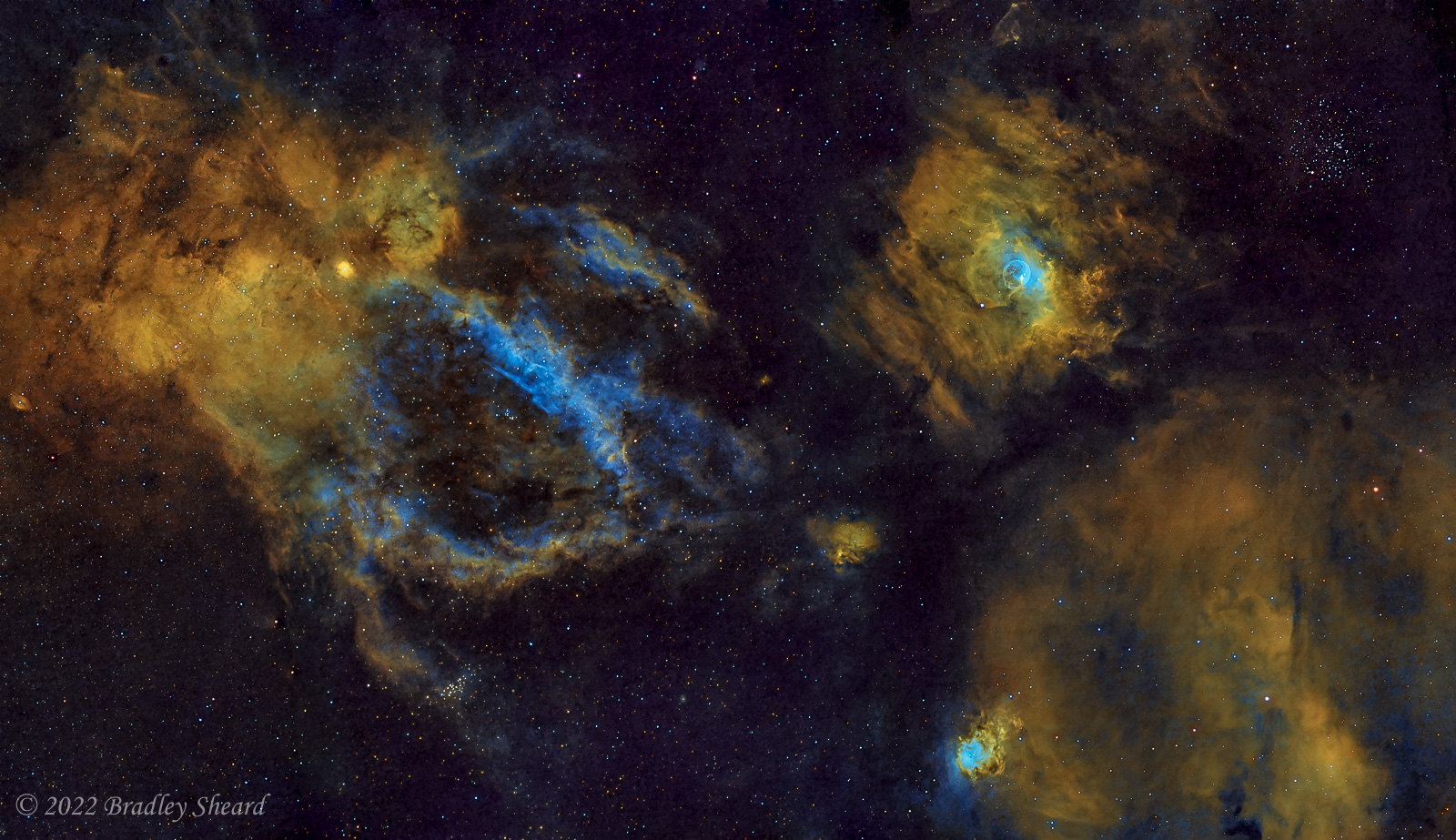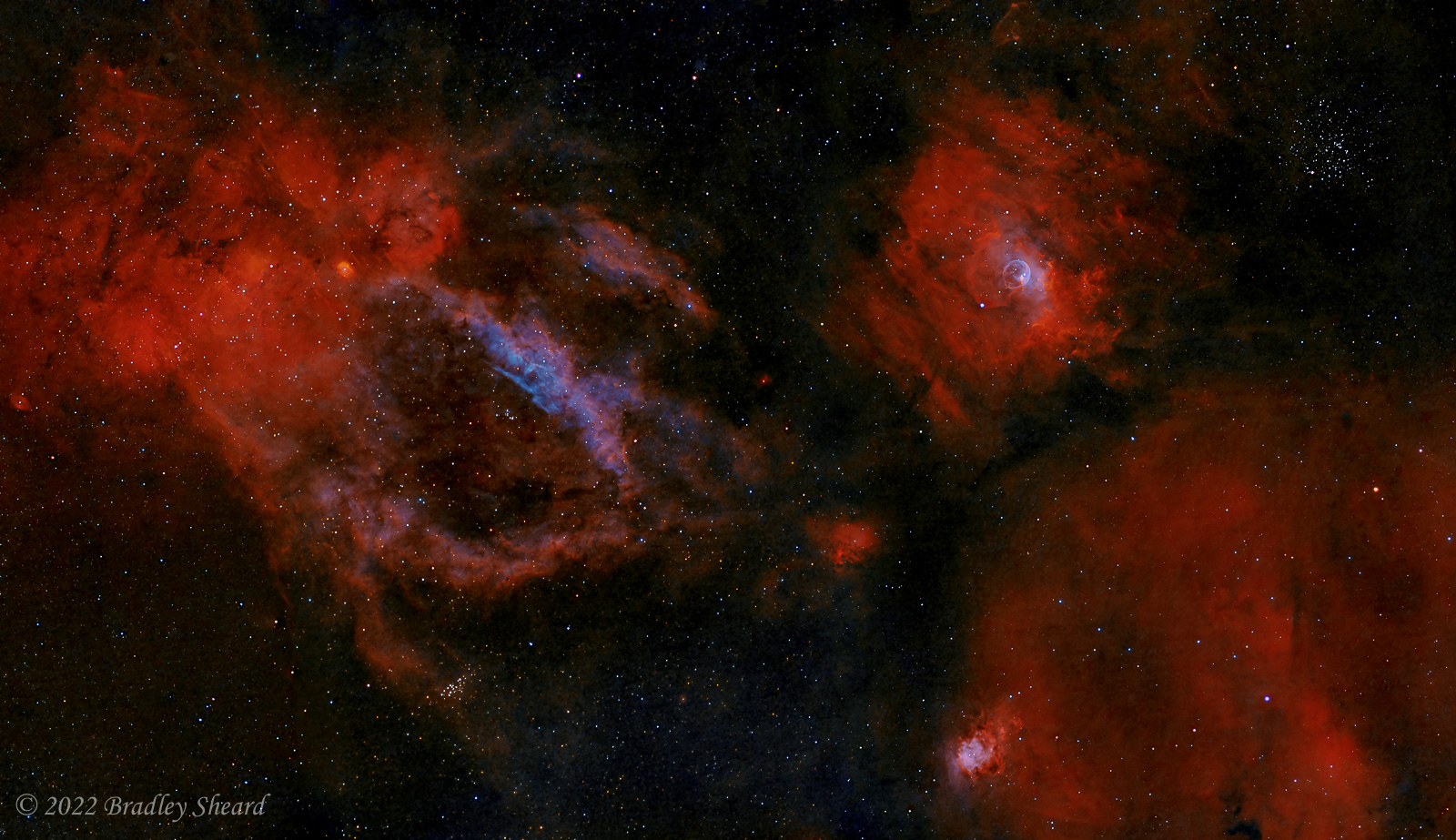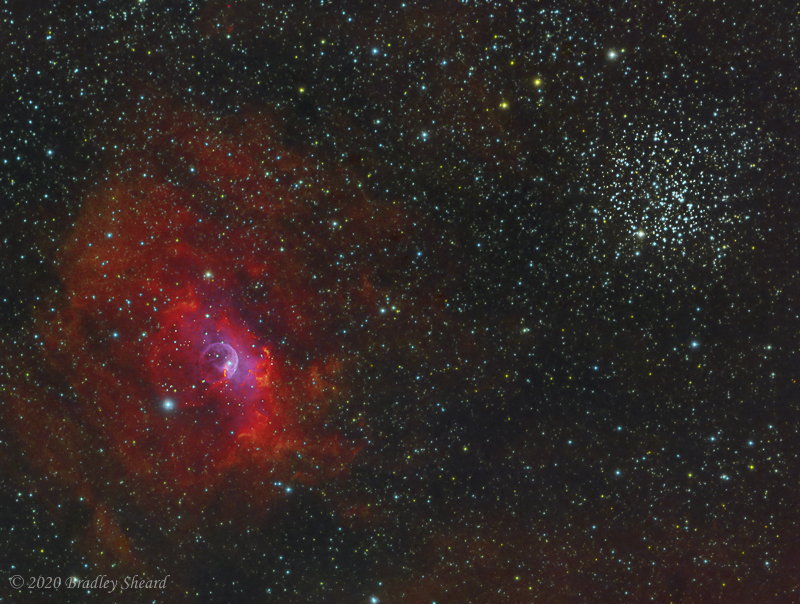M52 to Sharpless 2-157 | |||
| « Previous | Back to Astrophotography Gallery | Next » | |
 | |||
This is 3 frame mosaic stretching across the border of the constellations Cassiopeia and Cepheus. At upper right is the open cluster M52, and just to the left of this cluster is the beautiful Bubble Nebula (NGC 7635). The aptly named, but tiny (in this widefield view, it sits in the middle of the blue region buried in the larger yellowish gas clouds) Bubble Nebula is a shell of gas created by the outflowing stellar wind of a massive central star, and is estimated to measure approximately 7.5 light years across. To the left of the Bubble Nebula is the large complex of Sharpless 2-157, which to me appears a bit like a crab claw. Near the very bottom of the lower faint arm of this emission nebula lies another tiny open cluster of stars, NGC 7510. A number of other areas of nebulosity are also visible, such as the large diffuse Sharpless 2-161 at lower right, and embedded in its edge the small, bright nebula NGC 7538. The image was processed in a modified Hubble palette, with additional exposures through RGB filters to capture more accurate colors of the starfield. | |||
| Optics: | Stellarvue SVQ100 | ||
| Camera: | ZWO ASI 1600MM cooled CMOS camera | ||
| Exposure info: | ~ 21 hours total exposure split across 3 frames | ||
| Filters used: | Astrodon H-alpha, SII (5 nm), OIII (3 nm), Red Continuum, Astronomik RGB | ||
| date: | October/November 2017 | ||
| color mapping: | modified Hubble palette | ||
| processing: | Pixinsight-->Photoshop-->Lightroom | ||
Below is another version of this same image in a different color palette (Red = Halpha, Green = SII, Blue = OIII). An annotated version will appear on mouse roll-over labeling the major features. | |||
 | |||
 |
The open star cluster M52 (NGC 7654), in the image at left (cropped from the mosaic above), is a relatively rich cluster containing an estimated 6,000 stars or more (to magnitude 19.5, per Reference 4). The cluster's distance from earth is estimated to be ~1380 pc (~4500 light years). Age estimates for the members of the cluster have varied from approximately 25 Myrs to 160 Myrs, with Reference 4 concluding that 'The star formation seems to be a gradual process in which low mass stars are formed slowly over a long period of time and the process terminated with the formation of the most massive stars.' The most interesting feature in the image at left, however, is NGC 7635, the 'Bubble Nebula.' This nearly spherical shell or bubble, is created by the stellar wind of the central star, BD+60° 2522 (SAO 20575). This 'central star' is not actually centered within the bubble, however, a fact whose cause seems to be the subject of varying opinions in the technical literature. This is an O-class unevolved star (ie. on the main sequence and burning hydrogen in its core) with enough out-flowing stellar wind to create the visible bubble in the interstellar medium (ISM). To quote from Reference 1: 'A bubble of hot, shocked gas is formed when the wind of a star is converted from kinetic energy to thermal energy as it collides with the surrounding ISM. Around hot stars, a wind bubble expands within the photoionized HII region that surrounds the star...' The angular diameter of the visible bubble from our vantage point is ~3 arcmin, which at the star's estimated distance of 2.7 kpc (~8800 light years) equates to a bubble diameter of ~2.3 pc (~7.5 light years). That the driving star is displaced significantly from the geometric center of the bubble has several proposed explanations. One explanation is that the ISM is denser on one side of the bubble than the other, slowing the expansion of the bubble in that direction (Reference 3). Another proposed explanation (Reference 1) is that the star's proper motion through space (determined by the Gaia DR2 data to be 28 km/s) is creating a 'bow shock' as it moves through the ISM. Whatever mechanism is at work, the resulting Bubble Nebula is certainly a beautiful feature of this region of space! |
|
REFERENCES 1. Green, Mackey, Haworth, Gvaramadze and Duffy, 'Thermal Emission from Bow Shocks, 2D Hydrodymnamic Models of the Bubble Nebula.' Astronomy & Astrophysics, March 2019 2. Rauw, De Becker and Vreux, 'Line Profile Variability in the Specra of Oef Stars I. BD +60 2522.' Astronomy & Astrophysics, November 2002. 3. Moore, Walter, Scowen, Dufour and Buckalew, 'Hubble Space Telesocpe Obsdervations of the Windblown Nebula NGC 7635.' The Astronomical Journal, 2002 December. 4. Pandey, Nilaskshi, Ogura, Sagar and Tarusawa, 'NGC 7654: An Interesting Cluster to Study Star Formation History.' Astronomy & Astrophysics, 2001. | |